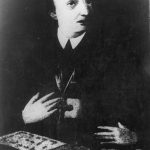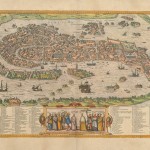Title: Dictionarium quinque nobilissimarum Europae linguarum : Latinae, Italicae, Germanicae, Dalmatiae [!] et Ungaricae ; Vocabula Dalmatica quae Ungari sibi usurparunt ; Institutio christiana ; Symbolum apostolorum / [Fausti Verantij].
Impressum: Venetiis : apud Nicolaum Morettum, 1595.
Material description: [8], 128 pp. : illustr. ; 8o (20 cm).
Author: Vrančić, Faust (1. 1. 1551–20. 1. 1617)
Collection: Zbirka rukopisa i starih knjiga NSK • Gajeva knjižnica
Access: Digitalna zbirka NSK
Impressum: Venetiis : apud Nicolaum Morettum, 1595.
Material description: [8], 128 pp. : illustr. ; 8o (20 cm).
Author: Vrančić, Faust (1. 1. 1551–20. 1. 1617)
Collection: Zbirka rukopisa i starih knjiga NSK • Gajeva knjižnica
Access: Digitalna zbirka NSK
In Venice in 1595, Faust Vrančić wrote and published the first dictionary of the Croatian language, which included Croatian among the five most noble languages of Europe. The starting column is in Latin (Latine), followed by Italian (Italice), Croatian (Dalmatice), German (Germanice) and Hungarian (Ungarice).
Vrančić here refers to the Chakavian dialect as the Dalmatian language, which at that time was a language of literature and in the past it was spoken in a much wider area than today. It spread not only on the islands, but also in most of Dalmatian region, in Lika, the Kupa basin, Slavonia and a part of Bosnia, while several experts believe that it was also spoken in Dubrovnik. Since Vrančić was from Šibenik, the Chakavian dialect was very close to him and he considered it the most beautiful among the three Croatian dialects. Its blossoming and culmination are felt in the 16th century. The father of the Croatian literature Marko Marulić wrote his work Judita in the Chakavian dialect, while in the reports of the Venetian syndics sent to the Venetian government in 1553, we can read: “All citizens of Split live according to their Slavic habit and custom, their mother tongue being so sweet and lovely to have a priority in Dalmatia, just like the Tuscan dialect in Italy, which can be called the flower and the most beautiful and best Italian dialect.” Turkish attacks as early as in the 15th century resulted in moving the Shtokavian-speaking population from the southeast to the northwest, therefore many Chakavian and Kajkavian-speaking people left their place of residence.
Vrančić’s Dictionary was also used by Hieronymus Megisser (1553-1618) while writing Thesaurus polyglottus (1603) as well as by Croatian lexicographers Jakov Mikalja (1600/1601-1654), Juraj Habdelić (1609-1678), Ivan Belostenec (1593/4-1675) and Ardelio Della Bella (1655-1737), while they were writing their dictionaries.
In Prague in 1605, the Czech Benedictine Petr Loderecker († 1636) prepared the 2nd edition of Vrančić’s five-language dictionary, adding, with Vrančić’s permission and generous help, the Czech (Bohemice) and Polish (Polonice) columns, which as well as the German column were print in the gothic scripture.
The third edition of Vrančić’s dictionary entitled “Dictionarium pentaglottum” was prepared and published in Bratislava in 1834 by the Hungarian physician and lexicographer József Török (1813-1894), the 1971 fourth edition is a bibliophile reprint by “Liber”, a publishing house of the Literary Science Institute of the Faculty of Philosophy, University of Zagreb. In 1984, a Czech Slavist Antonín Měšťan (born in 1930) reprinted Loderecker’s seven-language edition while the Society of Croatian Writers in Zagreb published the 6th edition in 1990, “Novi Liber” in 1992 prepared the 7th edition, which is an authentic reprint of the first. In 2005, “Novi Liber” reprinted the 1605 edition as well.
Source: Digitized heritage (author of the text: Ivan Kosić, Ph.D., 2005)


